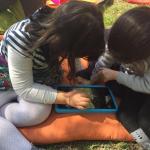Is it a real teaching for the five-year-old children or is it a game which will not bring any result?
Primary tabs
Author:
This is a matter that worries parents, and they often ask me that question when I present the first year syllabus for the 5-6-year-old learners. But seeing that learners begin reading, entering some words into the computer and making up sentences, without any tension, while playing in the result of their general development activities, parents stop worrying and turn into our partners more with more confidence.
I have recently done a small observation. I noticed that the learners recognize the Latin letters easier and quicker. Where does the secret lie? In the result of my observations I came to this conclusion: notices, favorite toys, candies, any ICT means or a device of digital electronics have English words on them. The learners constantly see these letters everywhere and also wonder what is written there and read the word by simply repeating what we say. That very fact prompted me the solution to the problem of teaching Armenian letters quickly and effectively. I decided to write the learners’ names on their desks in the classroom so that they could see and read their and their friends’ names. Soon they were happy because they could read their names and recognize the letters in them. Then the name reading activity turned into a game. They began to compare their names with their friends’ names. They wanted to find out whether there were any common letters in their names or whether there was a letter in a name which couldn’t be found in another name. Then we began to write and read other words with the already known letters. As it was already autumn, we wrote the word “աշուն” which means “autumn” Armenian. A month later the learners knew enough Armenian letters to make up different words with them. If they didn’t know any letter, they tried to remember in whose name it could be found. They already could enter their names into the computer, restore already known words with mixed letter order or simple sentences with mixed word order. At the end of the second month some learners were already able to read short tales. At the end of February almost all of them could read. While reading and learning a new word the learners shouted in a loud voice in whose name they had met this or that letter.
Now we read a lot during a day. Some learners use a tablet, others use a net-book or a paper book. They read alone or in pairs. It is especially interesting for them to read in pairs. They read in turn: one learner reads one word, and the other reads the next word and then they discuss what they have read. (Examples: Mary and Vachagan, Eva and Davit )
To develop reading comprehension we use correspondence. I write letters to a definite learner, to a group of learners or to the whole class:
· Aram and Ann, you are on duty today.
· Davit and Vachagan, water the flowers please.
· Razmik, a piece of paper is lying next to your chair, pick it up.
· It is lunch time. Let’s go to the canteen.
· It is warm and sunny today. Let’s go out into the school yard to play.
I write such letters on the electronic interactive board so that everybody might see them, read and do what is written on the board. We follow some rules in class. If the letter is addressed to the whole class, the learners read the sentences in a low voice and then do what is written without speaking. If the letter is addressed to definite learners, they stand up and say what is written in the letter and then act. If a learner hasn’t been attentive and hasn’t understood the letter addressed to him/her, other learners explain to him by reading the letter together. This is a fun game project which helps the learner to overcome fear of reading, promotes attention and values the necessity of being able to read and comprehend what is written. We have worked out certain rules for this game:
· Read the message carefully
· Comprehend what is written
· Perform the command in the right way
· Keep silent, do not disturb or promt your friend
Now there are some learners who write letters to me from home, and they get happy when I quickly reply to their letter. For example, Davit decided to send me a smile sign with this message: “Ms Armine, do not think this smile sign is sad. It is happy because you are very good.”
Now all the learners compose their own tales, and I help them to enter their compositions into the computer. We, certainly, read all these tales at home or in class. Then we begin discussing them and expressing our opinions. The learners read their friends’ tales with pleasure. To read these tales they switch on their tablets and open our class blog.
To stimulate reading I try to organize it by playing games. I choose a tale which they know very well. Then I enter 4 different parts of the tale into 4 tablets. Then the class is divided into different groups. The task is to read one part and guess which tale it is. Here is another activity: I enter only one word into each tablet and the learners’ task is to put the tablets in the right order so that a sentence is made up. Sometimes such active and cheerful games are invented spontaneously in class.
My learners’ any little progress makes me happy. I am happy that now they can read, entries into the computer and express their ideas. My next step will be teaching them handwriting, writing in pencil. I don’t know when exactly it will be, but we will not hurry and will certainly do it by playing games.

